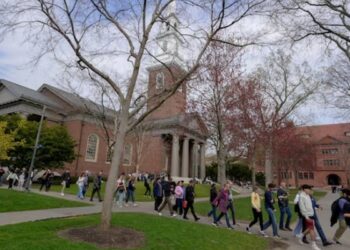Harvard University’s Research Funding Landscape
Harvard University, as one of the United States’ most prestigious educational institutions, has a diverse funding structure that plays a crucial role in sustaining its operations, particularly in research. In light of recent developments surrounding federal funding and administrative policies, understanding the intricacies of Harvard’s funding model is more pertinent than ever.
Overview of Funding Sources
Harvard’s revenues for fiscal year 2024 come from three primary sources: philanthropy, education, and research. Each of these categories contributes significantly to the university’s financial health and its ability to conduct groundbreaking research across various disciplines.
Philanthropy
Philanthropy is a cornerstone of Harvard’s financial infrastructure. This category includes funds generated from endowment income and generous donations from alumni and other benefactors. The endowment, accumulated over centuries, provides a stable income stream, which is vital for long-term financial planning and sustainability.
Education
The education sector encompasses multiple aspects of university life, including:
- Tuition Fees: A significant source of revenue, tuition fees are charged to undergraduate and graduate students.
- Housing and Meal Plans: The university generates income from on-campus accommodations and dining services, which not only cater to student needs but also contribute to the overall budget.
- Financial Aid: Harvard’s robust financial aid program aims to ensure that students from diverse economic backgrounds can afford a Harvard education. This investment is crucial for maintaining the university’s commitment to accessibility and inclusivity.
Research Funding
Research funding at Harvard is divided into two categories: federal and non-federal sponsored research. This breakdown reveals the reliance on government funding for advancing innovative research initiatives.
-
Federal Sponsored Research: Accounting for approximately 11% of Harvard’s overall budget, federal funding supports various projects, including critical explorations in health, technology, and the sciences.
ADVERTISEMENT - Non-Federal Sponsored Research: This category, making up around 5% of the budget, includes grants from private foundations, corporations, and other entities that contribute to specific research endeavors.
Implications of Funding Freezes
Recent political dynamics, particularly the Trump administration’s actions regarding higher education funding, have directly impacted Harvard’s fiscal stability. The suspension of $2.2 billion in research funding has raised significant concerns about ongoing and future research projects.
Affected Research Areas
The freeze on research funding has considerable implications for various ongoing projects, including:
-
Radiation Exposure Studies: Research aimed at understanding the health impacts of radiation exposure, crucial for both medical and safety applications, has been halted.
-
Tuberculosis Treatment Innovations: Projects that seek to develop new therapies and interventions for tuberculosis, a global health concern, are now jeopardized due to funding shortages.
- ALS Diagnostics: Research focused on amyotrophic lateral sclerosis (ALS) has faced significant disruptions, affecting potential breakthroughs in diagnostics and treatment options for this debilitating disease.
Financial Operations Breakdown
In fiscal year 2024, Harvard’s total operating costs reached approximately $6.4 billion. The expenditure is systematically categorized into three main areas:
People
The largest portion of the budget is allocated to personnel costs, which includes salaries, wages, and employee benefits. This allocation is essential for attracting and retaining top faculty and staff, who drive Harvard’s academic and research missions.
Space
Space-related costs encompass expenses associated with maintaining and operating university facilities. This includes occupancy costs, depreciation of facilities, and interest payments on bonds used for capital projects.
Other Expenses
The remaining budget is allocated to various other services, including:
-
Purchased Services: This can include consulting services, IT support, and other outsourced functions that are crucial for efficient university operations.
- Supplies and Equipment: Funds in this category help maintain laboratories, classrooms, and other necessary resources that enable effective teaching and research.
The unique convergence of Harvard’s funding model amidst a backdrop of political tension underscores the careful balance the university must navigate between sustaining its operations and complying with varying administrative demands. The implications of financial freezes and the ongoing pursuit of diverse funding sources are critical elements that will shape the university’s future strategies and initiatives.






